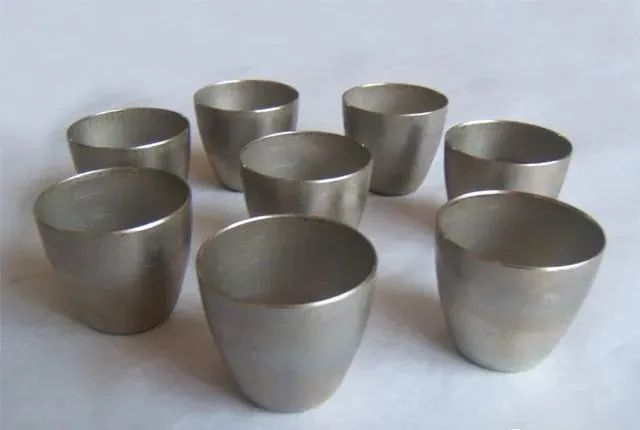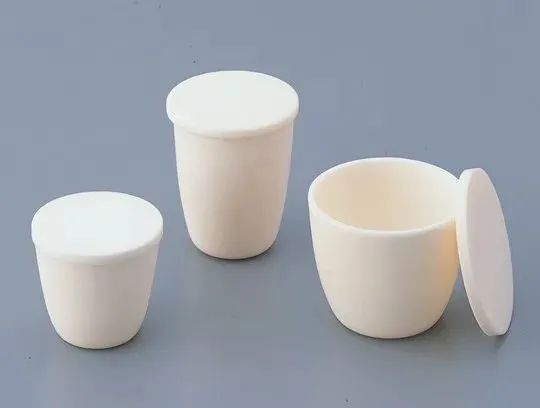1. What is a crucible?
Crucibles are vessels or melting pots made of extremely refractory materials such as clay, graphite, china clay, or metals that are harder to melt.
2. How to use the crucible
The crucible is a bowl-shaped container with a ceramic deep bottom. Crucibles must be used when solids are to be heated with a high fire. Because it can withstand high temperatures better than glassware.
When the crucible is used, the crucible cover is usually placed on the crucible to prevent the heated object from jumping out, and to allow the air to enter and exit freely for possible oxidation reactions.
Because the bottom of the crucible is small, it generally needs to be placed on a mud triangle to be directly heated by fire. The crucible can be placed upright or obliquely on the iron tripod, and can be placed by itself depending on the needs of the experiment.
Do not place the crucible on a cold metal table immediately after heating to avoid it breaking due to rapid cooling. Do not immediately put it on the wooden tabletop to avoid burning the tabletop or causing a fire. The correct way is to leave it on an iron tripod to cool naturally, or put it on an asbestos mesh to cool it slowly. Please refer to the crucible tongs for access to the crucible.
3. Classification of crucibles:
1. Graphite crucible
Among the graphite crucibles, there are three types: ordinary graphite crucibles, special-shaped graphite crucibles and high-purity graphite crucibles. Various types of graphite crucibles have different raw materials, production methods, process technologies and product model specifications due to different properties, uses and conditions of use.
The main raw material of graphite crucible is crystalline natural graphite. Therefore, it maintains various physical and chemical properties of natural right ink.
That is, it has good thermal conductivity and high temperature resistance. In the process of high temperature use, the thermal expansion coefficient is small, and it has certain strain resistance to rapid heating and rapid cooling. It has strong corrosion resistance to acid and alkaline solutions, and has excellent chemical stability.
There are many types and specifications of crucibles, and they are not limited by production scale, batch size and variety of smelting substances in application.
Graphite crucibles are widely used in the smelting of alloy tool steel and the smelting of non-ferrous metals and their alloys in metallurgy, casting, machinery, chemical and other industrial sectors because of the above excellent properties. And has better technical and economic effects.
2. Nickel crucible
It is suitable for melting samples of NaOH Na2O2, Na2CO3 NaHCO3 and alkaline solvent containing KNO3.

3. Quartz Crucible
Quartz crucibles can be used below 1450 degrees, and are divided into two types: transparent and opaque. The semi-transparent quartz crucible made by the arc method is an indispensable basic material for drawing large-diameter single crystal silicon and developing large-scale integrated circuits. Today, the developed countries of the world’s semiconductor industry have replaced the small transparent quartz crucible with this crucible. It has the advantages of high purity, strong temperature resistance, large size and high precision, good heat preservation, energy saving and stable quality.
4. Porcelain crucible
It can be heat-resistant to about 1200 degrees, and is suitable for melting samples of acidic substances such as K2S207. Generally, it cannot be used for melting with alkaline substances such as Na0H, Na202, Na2CO3, etc., so as not to corrode the porcelain crucible. Porcelain crucibles should not be in contact with hydrofluoric acid. Porcelain crucibles can generally be cleaned by boiling with dilute HCl.
5. Corundum Crucible
Corundum crucible is composed of porous fused alumina, which is firm and refractory. Corundum crucible is suitable for melting samples with some weak alkaline substances such as anhydrous Na2C03 as flux, but not for melting samples with strong alkaline substances and acidic substances such as Na 202 and NaOH as flux (such as K2S 207, etc.).

